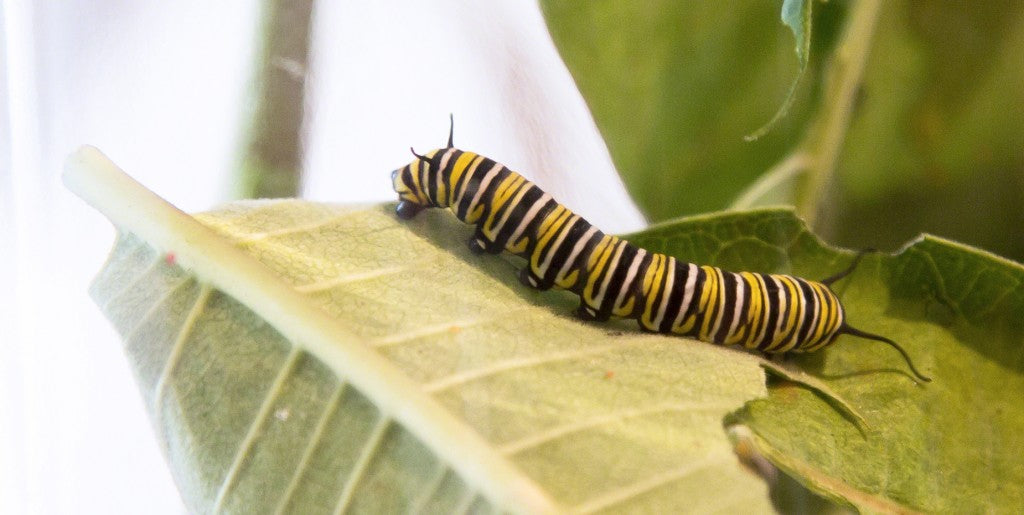 Two chrysalises housing monarch pupa
Two chrysalises housing monarch pupaVermont Woods Studios Prepares Monarchs for Take-off
On a beautiful day straddling the line between August and September, we huddled on the deck of Vermont Woods Studios at our Stonehurst property. Five adults and two children all gazing in mirrored excitement at the progress of our monarch caterpillars as they forge their ways into butterfly-hood.
“I’m going to name him Jeff!” One of the young boys informed the group as Peggy Farabaugh, the CEO of Vermont Woods Studios and head caterpillar-rearer, gently scooped up two prized caterpillars and secured them safely in a jar for the boys to bring to their grandmother’s.
It has been two weeks since the arrival of the caterpillar babies (or larva) and already they are well on their way to adulthood. However, their transformation is far more magical than that of any other aging process. They came to us as tiny creatures no bigger than a grain of rice and have rapidly transformed into vibrant, two inched beauties that scuttle about their mesh hamper confinement eating milkweed and maturing with natural grace.
It is marvelous to watch the caterpillars inch their way to the top of the hamper and methodically suspend themselves upside down in a J shape. This is a signal to the world that the caterpillars are ready to enter the pupa or chrysalis stage of life. The caterpillars work tirelessly in this J-shape to molt their skin and transform their outer appearance into the grass green, gold speckled chrysalis.
“I wonder what they’re doing in there all the time.” Peggy mused, affectionately grooming the caterpillar habitat. The allure of mystery gripped us all as we watched the beautiful chrysalises hang, cautiously enveloping the transforming caterpillar.
In about two weeks the chrysalises will have turned black and the monarch butterfly will be ready to emerge with damp, fledgling wings. In the short span of two hours, the monarch’s wings will dry and it will be lusting for flight. Thus our babies will leave us and safety of the Stonehurst deck.
However, it won’t be a sad day, for on this day we will have reached our goal. With the help of Orley R. “Chip” Taylor, founder of the Monarch Watch program at the University of Kansas, we will have completed cycle one of the Monarch Restoration project. The Vermont Woods Studios company developed an objective: to help restore the monarch population. Success is heavily contingent on three pillars: milkweed restoration, healthy, migration-ready monarchs and continued research.
Last October and November, Peggy and the Vermont Woods Studios staff went out in search of milkweed. Pods gathered along route 142 were brought back to the studio where seeds were harvested and packaged for distribution.
Seeds were distributed to local gardeners and nature enthusiasts, clients and planted on the Stonehurst property. 1 in 100 milkweed seeds strewn across the earth will produce a plant. Because of these small odds, we chose to carefully plant 80 seeds on the Stonehurst property yielding 80 viable milkweed plants.
Along with learning the importance of carefully planting the milkweed seeds, the Vermont Woods Studios staff have also developed important information for rearing monarch caterpillars:
- Whenever it is possible, raise the caterpillars in a terrarium
- Do not allow direct sunlight to hit the terrarium
- Monarch caterpillars grow quickly and this process can be messy, so cleaning the terrarium frequently is a must
 One of our monarch caterpillars getting ready to transition into a chrysalis
One of our monarch caterpillars getting ready to transition into a chrysalisOnce our monarchs are ready for flight, we have one last piece of the puzzle to put in place before we can call the project a success. Chip founded Monarch Watch in 1992 and has been studying monarch migration since 2005. The eastern monarchs born at the end of the summer months have the innate task of migrating to Mexico. This migration will take four generations of monarchs.
Our Stonehurst monarchs will fly just a portion of the way and then stop to lay eggs and die as the new babies begin the growing process and mature to fly their portion of the trip. This process will repeat until the final generation sails over sunny Mexico and makes themselves comfortable for eight to nine months when the United States is again habitable for the return of the monarchs.
How did people come to have such intimate detail about the migration pattern of these tireless creatures? The answer to this is evolving through research, which brings us to the final stage of the project: tagging the monarchs.
Before our monarchs take flight, we will place a small, adhesive tag, provided by Chip and his team on the wings of our monarchs. These tags will signal researchers to know where the monarchs came from and provide other valuable research that will continue to help rehabilitate the monarch population.
As we stand on the deck, without a chill in the air and watch the chrysalises form, we know the journey our caterpillars have before them. We discuss tagging the butterflies with nervous laughter, none of us having ever done it before; but were willing to try because we know that it is one key step in encouraging the comeback of these magical creatures.
(This is part two of a four part blog series on our Monarch Butterfly Restoration Project)

